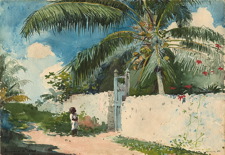Infrared Detail: Two figures in original design
Infrared examination of A Garden in Nassau reveals that the watercolor originally included two older boys perched atop the wall to the left of the wooden gate; they were attempting to reach the clustered coconuts on the other side. In this original composition, the small child standing in the path may have been stationed as a lookout for the two older children. Once the two figures were removed, the role of this youngster changed. In the final scene, focus is on the child’s wistful longing for forbidden fruit.
Examination of the paper’s surface indicates that the artist also painted the figures, at least with preliminary washes, and then erased the area by scraping, leaving partial outlines of the forms behind. Nineteenth-century watercolor manuals discussed scraping as a means to remove unwanted design passages and then recommended resurfacing the scraped area: “If it be necessary that the part thus scraped should be afterwards tinted, it must first be rubbed with a piece of clean india-rubber, then smoothed by the application of any hard surface . . . the color will then lie . . . quite as well as on the unbroken surface of the paper” (Rowbotham 1880, p. 27). A porcelain-tipped burnisher (Portland Museum of Art, Maine) exists among the contents of Homer’s studio, but there is no evidence he employed it in this work. Lifted and disturbed fibers are evident throughout the passage, indicating that he did not burnish the area before reapplying watercolor. The uneven fibers and absence of surface size made it more challenging for him to control the subsequent washes. Ultimately, the artist was less concerned with the surface finish than with the broader impression of his finished painting.
Infrared detail of A Garden in Nassau, showing two figures climbing the wall to pick coconuts (1.5 – 1.73 µm).


